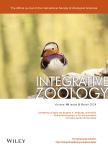Substrate use and postural behavior in free-ranging snub-nosed monkeys(Rhinopithecus bieti)in Yunnan
作者机构:School of AnatomyPhysiology and Human BiologyUniversity of Western AustraliaCrawleyAustralia College of Life SciencesChina West Normal UniversityNanchongSichuanChina Key Laboratory of Animal Ecology and Conservation BiologyInstitute of ZoologyChinese Academy of SciencesBeijingChina
出 版 物:《Integrative Zoology》 (整合动物学(英文版))
年 卷 期:2013年第8卷第4期
页 面:335-345页
核心收录:
学科分类:0710[理学-生物学] 07[理学] 0905[农学-畜牧学] 0906[农学-兽医学] 070303[理学-有机化学] 0703[理学-化学]
基 金:funded by Janggen-Pöhn-Stiftung A.H.Schultz Stiftung Zürcher Tierschutz G.&A.Claraz-Schenkung Goethe-Stiftung Jane Goodall Institute Schweiz the Kommission für Reisestipendien der Schweizerischen Akademie der Naturwissenschaften SANW the Offield Family Foundation Primate Conservation,Inc. the Zoological Society of San Diego the Primate Action Fund of Conservation International.
主 题:China colobine positional behavior posture terrestriality
摘 要:Extant colobines represent a predominantly arboreal primate radiation,but there are outliers such as some species of snub-nosed monkeys(Rhinopithecus spp.)that utilize both arboreal and terrestrial substrates.We quantified the degree of terrestriality and the distribution of individuals across canopy levels,the extrinsic and intrinsic determinants and constraints of strata association as well as use of postures in relation to behavior and food sources in a wild population of Yunnan snub-nosed monkeys(Rhinopithecus bieti)in the Samage Forest,China.The subjects spent 80.5%of the observation time in the trees and 19.5%on the ground.Ground use occurred most frequently in the context of travelling(61%)and less often in the context of feeding and resting(30%combined).Adult males frequented the ground significantly more often than other age-sex classes.Age-sex differences were also apparent in substrate preferences,which likely reflect body weight constraints.Adult males were significantly more associated with solid substrates and less with terminal branches than adult females and juveniles.Juveniles were seen more often on unstable ground(i.***.on thin and oblique branches)and in the upper canopy.Substrate use also varied with behavior:feeding was much more common in the upper stratum,outer canopy,on highly inclined and thin branches,as compared to resting.Severe weather also influenced canopy use in that tree crowns were used less often during periods of snowfall.The most frequently exhibited resting and feeding postures was sitting.Standing and suspensory postures were most often used in the context of feeding on lichens.



